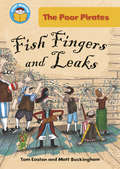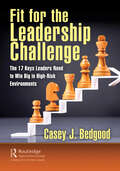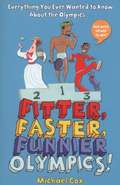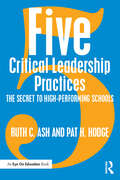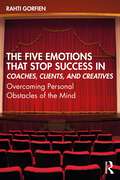- Table View
- List View
First-Year Teaching For Dummies
by Carol Flaherty Flirtisha Harris W. Michael KelleyMake your first year of teaching one to remember Becoming a new teacher is one of the most fun, exciting, and challenging experiences you’ll encounter in your life. Who wouldn’t want a little help getting ready before sitting down behind the teacher’s desk for the first time? That’s where First-Year Teaching For Dummies comes in. You’ll find easy-to-follow strategies and techniques to help you navigate the politics of education in your community, develop fun and fulfilling relationships with your students, and refine your own instructional style. You’ll learn to: Survive and thrive in your first two weeks as you hit the ground running and win over your students, co-workers, and administrators Avoid or reduce the major stressors that can lead to burnout and other common problems Understand and handle 21st-century issues with skill and sensitivity It’s almost time for you to take charge of your first classroom and you’re raring to go. So, grab a copy of First-Year Teaching For Dummies to find the last-minute tips and common-sense guidance you need to help make your first school year a rewarding one!
First-Year University Writing: A Corpus-Based Study with Implications for Pedagogy
by L. AullFirst-Year Writing describes significant language patterns in college writing today, how they are different from expert academic writing, and how to inform teaching and assessment with corpus-based linguistic and rhetorical genre analysis.
First Years At School (UK Higher Education OUP Humanities & Social Sciences Education OUP)
by Angela AnningReview of 1st edition"I found the whole account a model of clarity with a good blend of theory and practice which many authors would do well to note"Ted Wragg, TESThe First Years at School (2nd Edn) is a practical and reflective discussion of the education of 4 to 8 year olds based on a sympathetic recognition of the complexities of being an early years teacher. Angela Anning begins by reviewing the historical and ideological traditions of British infant and primary schools, tracing how we have reached the position where teachers feel themselves to be torn between child-centered and utilitarian demands in educating young children. She then provides a detailed and authoritative critique of recent thinking about the cognitive, social and emotional development of children, and explores the complexities of teachers' roles. She discusses the organization of the classroom, the structuring of learning in the school day and the content of the curriculum. She tackles the implications of the series of changes in the National Curriculum Orders and the national assessment systems for seven year olds and their impact on pre-fives and children with special educational needs. The second edition brings the debate about the post Dearing Key Stage One curriculum and its implications for pre-school education bang up to date. This will be vital reading for both student and practising teachers of young children.
First You Write a Sentence.: The Elements of Reading, Writing … and Life.
by Joe MoranA style guide by stealth - how anyone can write well (and can enjoy good writing)'Moran is a past master at producing fine, accessible non-fiction.' - Helen Davies, Sunday Times'Joe Moran has a genius for turning the prosaic poetic' - Peter HennessyAdvanced maths has no practical use, and is understood by few. A symphony can be widely appreciated, but created only by a genius. Good writing, however, can be written (and read) by anyone if we give it the gift of our time. And a sentence might be as near as many of us will get to orchestrating beauty. Enter universally praised historian Professor Joe Moran. Using minimal technical terms, First You Write a Sentence. is his unpedantic explanation of how the most ordinary words can be turned into verbal constellations of extraordinary grace. With examples from the Bible and Shakespeare to Orwell and Diana Athill, and with support from scientific studies of what most fires people's minds, he shows how we can all write in a way that is vivid, clear and engaging. With chapters from tools of the trade (from typewriters to texting and the impact this has on the craft); and writing and the senses (how to make the world visible and touchable); to how to find the ideal word, build a sentence, and construct a paragraph, First You Write a Sentence. informs by light example. It's an elegant gem in praise of the English sentence.
Fish Colours (Rigby Star Independent #Pink Level Non-Fiction)
by Mary WalkerHow many colourful fish are there in the sea?
Fish Colours (Rigby Star Independent #Pink Level)
by Mary WalkerHow many colourful fish are there in the sea?
Fish Fingers and Leaks: Poor Pirates: Fish Fingers And Leaks (Start Reading: The Poor Pirates #1)
by Tom Easton (Author)The Poor Pirates have stolen a bag full of fish fingers. Just as the men are about to sit down to eat, their ship, The Stuck Pig, starts to leak. Captain Flint orders his crew to plug the leaks, but they aren't very happy!
Fit for Business: Pre-Vocational Education in European Schools
by Matthias Pilz Susanne Berger Roy CanningWithin compulsory education, prevocational education is intended primarily to introduce participants to the world of work. This book considers curriculum design and pedagogical practice in pre-vocational education during the last two years of compulsory education. The study focuses on seven European countries (Scotland, Latvia, Poland, Hungary, Germany, Austria, Portugal) and presents an analysis of the curriculum as it relates both to knowledge-based competencies in economics and business and to self- and social competencies. It then discusses the differences between the prescribed and the enacted curriculum as identified by means of a subsequent survey of teachers. The authors conclude with a comparative assessment of each country case study, combined with supranational recommendations.
Fit for the Leadership Challenge: The 17 Keys Leaders Need to Win Big in High-Risk Environments
by Casey J. BedgoodThe key to effective leadership is being fit for the challenge. Leadership is a perpetual boxing match in many respects in which preparation, stamina and skill are required. Only the strongest survive. Every decision and tollgate along the career journey is laden with risk. Those leaders who harness risk to their advantage will land the knockout punch in every fight. The only question is how many leaders will be fit enough for the challenge? The purpose of this book is to provide insight as to how risk impacts every aspect of leadership, including the mundane, routine and nonglamorous aspects of leadership. This is important because often the small things can easily turn into big disruptors. Moreover, the end goal is to equip leaders with a journey map and quick guide to win in high-risk environments. Change is the new normal and only constant in today’s world. As change increases, so will risk and its subsequent impacts on humanity. This includes leaders, organizations and customers. No one is exempt. In this book, readers learn how to: Determine which career battles to fight and which ones to avoid Prepare to fight the unavoidable challenges along the career journey Leverage risk to choose the right leaders for the team Leverage risk to invest time wisely and avoid wasting it Leverage risk to predict, identify and resolve leadership burnout Risk assess leadership credentials so only those that produce a return are added to the portfolio Risk assess performance outcomes so the path ahead is smooth sailing instead of a rough ride Leverage risk so high performance is a reality instead of a pipe dream Leverage risk to find the right leadership sponsor
Fit for the Leadership Challenge: The 17 Keys Leaders Need to Win Big in High-Risk Environments
by Casey J. BedgoodThe key to effective leadership is being fit for the challenge. Leadership is a perpetual boxing match in many respects in which preparation, stamina and skill are required. Only the strongest survive. Every decision and tollgate along the career journey is laden with risk. Those leaders who harness risk to their advantage will land the knockout punch in every fight. The only question is how many leaders will be fit enough for the challenge? The purpose of this book is to provide insight as to how risk impacts every aspect of leadership, including the mundane, routine and nonglamorous aspects of leadership. This is important because often the small things can easily turn into big disruptors. Moreover, the end goal is to equip leaders with a journey map and quick guide to win in high-risk environments. Change is the new normal and only constant in today’s world. As change increases, so will risk and its subsequent impacts on humanity. This includes leaders, organizations and customers. No one is exempt. In this book, readers learn how to: Determine which career battles to fight and which ones to avoid Prepare to fight the unavoidable challenges along the career journey Leverage risk to choose the right leaders for the team Leverage risk to invest time wisely and avoid wasting it Leverage risk to predict, identify and resolve leadership burnout Risk assess leadership credentials so only those that produce a return are added to the portfolio Risk assess performance outcomes so the path ahead is smooth sailing instead of a rough ride Leverage risk so high performance is a reality instead of a pipe dream Leverage risk to find the right leadership sponsor
Fit für die jungen Generationen am Arbeitsplatz: Wie ticken sie und was macht sie aus
by Helene Einramhof-FlorianIn den letzten Jahren hat sich die Arbeitswelt grundlegend verändert, die Digitalisierung und die Globalisierung sowie der demographische Wandel schreiten voran und sowohl Arbeitgeber:innen als auch Arbeitnehmer:innen sind mit neuen Herangehensweisen konfrontiert. Das wird auch in den nächsten Jahren so bleiben. Der Fachkräftemangel, der sogenannte „war for talents“ wird sich weiter verschärfen. Und für die Menschen der jüngeren Generationen stehen andere Werte im Mittelpunkt als bei ihren Vorgängergenerationen. Zu den jüngeren Generationen zählen die Millennials und die Generation Z. Warum ist es für Unternehmen wichtig, sich mit diesen Generationen zu befassen? Was motiviert diese Arbeitnehmer:innen-Schicht? Wie ticken Zugehörige dieser Generationen? Welche Ziele haben sie? Welche Bedürfnisse möchten sie befriedigt wissen? Was sollten ihnen Unternehmen bieten, um attraktive Arbeitgeber:innen zu sein? Erfahren Sie, wie Sie sich als Führungskraft, Personalverantwortliche, Entscheidungsträger:innen, Arbeitgeber:innen und Unternehmer:innen an die Veränderungen des Arbeitsmarktes adaptieren und Sie das Bewusstsein für die jungen Generationen entwickeln, damit Ihr Unternehmen durch und gemeinsam mit dem Potenzial dieser Generationen wächst. Sie finden praktische Handlungsempfehlungen einiger Experteninterviews aus der D-A-CH-Region und Fallbeispiele für Ihren Arbeitsalltag mit den jungen Generationen.
Fitter, Faster, Funnier Olympics!: Everything You Ever Wanted To Know About The Olympics But Were Afraid To Ask (PDF)
by Michael Cox Steve MayFrom unbelievable tales of triumph (with all the shocking bits left in) to incredible facts about Olympic athletes, this is an aspirational, informative, interactive and hilarious guide to the Olympics - what they're all about and what made them what they are today. Packed with funny illustrations, inspirational ideas and amazing activities, this is a brilliant guide to the Olympics past and present.
Five Critical Leadership Practices: The Secret to High-Performing Schools
by Ruth C. Ash Pat H. HodgeWhat are the critical practices of leaders in high-performing schools? Based on extensive observations, interviews, and in-depth case studies of principals and superintendents who significantly increase student learning and achievement, this exciting new book provides novice and veteran school leaders with the five critical steps for effective school leadership: Focus on Direction Build a Powerful Organization Ensure Student-Focused Vision and Action Give Life to Data Lead Learning Rich with voices from highly effective leaders, this book provides an accessible, research-based framework for school improvement that is correlated with the field’s standards. The engaging case studies in this vital resource show the power of these five key critical practices to make a difference in the lives of students and transform schools to support learning for all.
Five Critical Leadership Practices: The Secret to High-Performing Schools
by Ruth C. Ash Pat H. HodgeWhat are the critical practices of leaders in high-performing schools? Based on extensive observations, interviews, and in-depth case studies of principals and superintendents who significantly increase student learning and achievement, this exciting new book provides novice and veteran school leaders with the five critical steps for effective school leadership: Focus on Direction Build a Powerful Organization Ensure Student-Focused Vision and Action Give Life to Data Lead Learning Rich with voices from highly effective leaders, this book provides an accessible, research-based framework for school improvement that is correlated with the field’s standards. The engaging case studies in this vital resource show the power of these five key critical practices to make a difference in the lives of students and transform schools to support learning for all.
Five Dimensions of Quality: A Common Sense Guide to Accreditation and Accountability
by Linda SuskieMeet calls for increased quality and understand accreditation expectations Author Linda Suskie is internationally recognized for her work in higher education assessment, and she is a former vice president of a major regional accreditor. In Five Dimensions of Quality: A Common Sense Guide to Accreditation and Accountability in Higher Education she provides a simple, straightforward model for understanding and meeting the calls for increased quality in higher education ever-present in today's culture. Whether your institution is seeking accreditation or not, the five dimensions she outlines will help you to identify ways to improve institutional quality and demonstrate that quality to constituents. For those wading through the accreditation process, which has become more difficult in recent years due to increasing regulation and pressure for greater accountability, Suskie offers expert guidance on understanding the underlying principles of the expectations of accrediting bodies. Using the model presented here, which is much easier to understand than the sometimes complex resources provided by individual accrediting bodies, American colleges and universities can understand what they need to do to earn and maintain their regional accreditation as well as improve overall institutional quality for their students. You'll be able to: Identify ways to improve institutional quality Demonstrate the quality of your institution to internal and external constituents Avoid wasting time and energy on misguided institutional processes to comply with accreditation requirements By focusing on why colleges and universities should take particular actions rather than only on what those actions should be, Five Dimensions of Quality gives them the knowledge and strategies to prepare for a successful review. It is an ideal resource for leaders, accreditation committee members, and everyone on campus.
Five Dimensions of Quality: A Common Sense Guide to Accreditation and Accountability
by Linda SuskieMeet calls for increased quality and understand accreditation expectations Author Linda Suskie is internationally recognized for her work in higher education assessment, and she is a former vice president of a major regional accreditor. In Five Dimensions of Quality: A Common Sense Guide to Accreditation and Accountability in Higher Education she provides a simple, straightforward model for understanding and meeting the calls for increased quality in higher education ever-present in today's culture. Whether your institution is seeking accreditation or not, the five dimensions she outlines will help you to identify ways to improve institutional quality and demonstrate that quality to constituents. For those wading through the accreditation process, which has become more difficult in recent years due to increasing regulation and pressure for greater accountability, Suskie offers expert guidance on understanding the underlying principles of the expectations of accrediting bodies. Using the model presented here, which is much easier to understand than the sometimes complex resources provided by individual accrediting bodies, American colleges and universities can understand what they need to do to earn and maintain their regional accreditation as well as improve overall institutional quality for their students. You'll be able to: Identify ways to improve institutional quality Demonstrate the quality of your institution to internal and external constituents Avoid wasting time and energy on misguided institutional processes to comply with accreditation requirements By focusing on why colleges and universities should take particular actions rather than only on what those actions should be, Five Dimensions of Quality gives them the knowledge and strategies to prepare for a successful review. It is an ideal resource for leaders, accreditation committee members, and everyone on campus.
The Five Emotions That Stop Success in Coaches, Clients, and Creatives: Overcoming Personal Obstacles of the Mind
by Rahti GorfienThis book uniquely identifies the five key emotions that prevent clients reaching their full creative potential and provides coaches tools to help them overcome them, boosting their productivity as well as their ability to complete and promote their work and personal development. Accessible and personable, Rahti Gorfien interweaves stories from her personal life and private practice to alleviate the burden of blockages creatives generated by their own divergent thinking, unconscious conditioning, and memory. She takes each mindset in turn, shame, grandiosity, envy, boredom, and fear, and explores each emotion and how coaches can practically help clients overcome them to achieve creative freedom and success personally and professionally. Filled with practical exercises and coaching theory throughout, this book will equip coaches with tools to inspire confidence in their clients to share their work with the world, silencing negative inner voices and fulfilling their professional creative goals. This book is invaluable reading for coaches as well as artists, entrepreneurs, therapists, career advisors, social workers and those interested in finding methods of overcoming personal obstacles to making meaningful and authentic contributions through the freedom of their singular and passionate pursuits.
The Five Emotions That Stop Success in Coaches, Clients, and Creatives: Overcoming Personal Obstacles of the Mind
by Rahti GorfienThis book uniquely identifies the five key emotions that prevent clients reaching their full creative potential and provides coaches tools to help them overcome them, boosting their productivity as well as their ability to complete and promote their work and personal development. Accessible and personable, Rahti Gorfien interweaves stories from her personal life and private practice to alleviate the burden of blockages creatives generated by their own divergent thinking, unconscious conditioning, and memory. She takes each mindset in turn, shame, grandiosity, envy, boredom, and fear, and explores each emotion and how coaches can practically help clients overcome them to achieve creative freedom and success personally and professionally. Filled with practical exercises and coaching theory throughout, this book will equip coaches with tools to inspire confidence in their clients to share their work with the world, silencing negative inner voices and fulfilling their professional creative goals. This book is invaluable reading for coaches as well as artists, entrepreneurs, therapists, career advisors, social workers and those interested in finding methods of overcoming personal obstacles to making meaningful and authentic contributions through the freedom of their singular and passionate pursuits.
Five Generations at Work: How We Win Together, For Good
by Rebecca Robins Patrick DunneThe definitive playbook for empowering intergenerational collaboration, innovation and productivity at work. Five Generations at Work: How we win together, for good explores how to maximise the dynamics of our generational diversity to create more collaborative and competitive organisations. An energising and pragmatic read, this book unpacks six years of research and work with organisations and individuals who are taking progressive action to lead from lenses versus labels, evidencing the value of generational diversity. For the first time in history, we have up to five generations at work. In the context of a world in flux and polycrisis, our diversity is a powerful force multiplier for good, if we debunk the stereotypes and know how to unlock it. Get inspired by exclusive case studies and conversations written through the voices of five generations and four continents across global corporates, family businesses, education and foundations, including: Ahlström I The EY Foundation I The Financial Times I Hoffmann-La Roche I Imaginable Futures I LVMH I Liberty Global I MARS I Mission 44 I The Oxford Character Project I St Gallen Symposium I The UNDP and Samsung and more …! Borrow and build on inspiring work from intergenerational alliances and intrapreneurs, to next generations and future generations Learn from case studies and solutions across diverse business contexts Apply the mindset, skillset and toolkits from work delivering shared value and sustainable impact Five Generations at Work: How we win together, for good is a transformative read for all business leaders, people leaders and CEOs. Importantly, it stands out because it was written for every generation – for students, first career movers, founders, managers, leaders and board members. Above all, this book is a call to action to us all. When humanity is being challenged by the forces upon us, from climate, to geopolitics, to technology, we need to draw on the strengths of every generation for sustainable and systemic change for good.
Five Generations at Work: How We Win Together, For Good
by Rebecca Robins Patrick DunneThe definitive playbook for empowering intergenerational collaboration, innovation and productivity at work. Five Generations at Work: How we win together, for good explores how to maximise the dynamics of our generational diversity to create more collaborative and competitive organisations. An energising and pragmatic read, this book unpacks six years of research and work with organisations and individuals who are taking progressive action to lead from lenses versus labels, evidencing the value of generational diversity. For the first time in history, we have up to five generations at work. In the context of a world in flux and polycrisis, our diversity is a powerful force multiplier for good, if we debunk the stereotypes and know how to unlock it. Get inspired by exclusive case studies and conversations written through the voices of five generations and four continents across global corporates, family businesses, education and foundations, including: Ahlström I The EY Foundation I The Financial Times I Hoffmann-La Roche I Imaginable Futures I LVMH I Liberty Global I MARS I Mission 44 I The Oxford Character Project I St Gallen Symposium I The UNDP and Samsung and more …! Borrow and build on inspiring work from intergenerational alliances and intrapreneurs, to next generations and future generations Learn from case studies and solutions across diverse business contexts Apply the mindset, skillset and toolkits from work delivering shared value and sustainable impact Five Generations at Work: How we win together, for good is a transformative read for all business leaders, people leaders and CEOs. Importantly, it stands out because it was written for every generation – for students, first career movers, founders, managers, leaders and board members. Above all, this book is a call to action to us all. When humanity is being challenged by the forces upon us, from climate, to geopolitics, to technology, we need to draw on the strengths of every generation for sustainable and systemic change for good.
Five Miles Away, A World Apart: One City, Two Schools, and the Story of Educational Opportunity in Modern America
by James E. RyanHow is it that, half a century after Brown v. Board of Education, educational opportunities remain so unequal for black and white students, not to mention poor and wealthy ones? In his important new book, Five Miles Away, A World Apart, James E. Ryan answers this question by tracing the fortunes of two schools in Richmond, Virginia--one in the city and the other in the suburbs. Ryan shows how court rulings in the 1970s, limiting the scope of desegregation, laid the groundwork for the sharp disparities between urban and suburban public schools that persist to this day. The Supreme Court, in accord with the wishes of the Nixon administration, allowed the suburbs to lock nonresidents out of their school systems. City schools, whose student bodies were becoming increasingly poor and black, simply received more funding, a measure that has proven largely ineffective, while the independence (and superiority) of suburban schools remained sacrosanct. Weaving together court opinions, social science research, and compelling interviews with students, teachers, and principals, Ryan explains why all the major education reforms since the 1970s--including school finance litigation, school choice, and the No Child Left Behind Act--have failed to bridge the gap between urban and suburban schools and have unintentionally entrenched segregation by race and class. As long as that segregation continues, Ryan forcefully argues, so too will educational inequality. Ryan closes by suggesting innovative ways to promote school integration, which would take advantage of unprecedented demographic shifts and an embrace of diversity among young adults. Exhaustively researched and elegantly written by one of the nation's leading education law scholars, Five Miles Away, A World Apart ties together, like no other book, a half-century's worth of education law and politics into a coherent, if disturbing, whole. It will be of interest to anyone who has ever wondered why our schools are so unequal and whether there is anything to be done about it.
Five Miles Away, A World Apart: One City, Two Schools, and the Story of Educational Opportunity in Modern America
by James E. RyanHow is it that, half a century after Brown v. Board of Education, educational opportunities remain so unequal for black and white students, not to mention poor and wealthy ones? In his important new book, Five Miles Away, A World Apart, James E. Ryan answers this question by tracing the fortunes of two schools in Richmond, Virginia--one in the city and the other in the suburbs. Ryan shows how court rulings in the 1970s, limiting the scope of desegregation, laid the groundwork for the sharp disparities between urban and suburban public schools that persist to this day. The Supreme Court, in accord with the wishes of the Nixon administration, allowed the suburbs to lock nonresidents out of their school systems. City schools, whose student bodies were becoming increasingly poor and black, simply received more funding, a measure that has proven largely ineffective, while the independence (and superiority) of suburban schools remained sacrosanct. Weaving together court opinions, social science research, and compelling interviews with students, teachers, and principals, Ryan explains why all the major education reforms since the 1970s--including school finance litigation, school choice, and the No Child Left Behind Act--have failed to bridge the gap between urban and suburban schools and have unintentionally entrenched segregation by race and class. As long as that segregation continues, Ryan forcefully argues, so too will educational inequality. Ryan closes by suggesting innovative ways to promote school integration, which would take advantage of unprecedented demographic shifts and an embrace of diversity among young adults. Exhaustively researched and elegantly written by one of the nation's leading education law scholars, Five Miles Away, A World Apart ties together, like no other book, a half-century's worth of education law and politics into a coherent, if disturbing, whole. It will be of interest to anyone who has ever wondered why our schools are so unequal and whether there is anything to be done about it.
Five Minute Mum: The Ultimate Guide for New School Starters
by Daisy UptonIs your little one starting school soon? Oh, goody! You've come to the right place.Getting your child ready to start school can feel overwhelming, can't it? It's a big step for both of you.Bestselling author and social media superstar, Daisy Upton, is here to help, and she has finally written a book for children! Daisy has two children in primary school, and used to be a teaching assistant, so she knows her stuff.Share this gentle, funny guide with your child to support them - and you! - with uniforms, meeting their first teacher, getting to school on the first day, making new friends, finding their way around, having fun at playtime, asking for help, packing their bag, learning about letters and numbers, going to assemblies, getting changed for PE, and much more.And, of course, this book includes lots of five-minute games and activities designed by Daisy to help your child feel confident and excited about taking the big step to big school.Starting School gives you and your little one glimpses of all the learning they will do and all the fun they will have.'I love Five Minute Mum - she's come up with games that are fun and educational' The Unmumsy MumAlso available: Five Minute Mum: Give Me FiveFive Minute Mum: Time For SchoolFive Minute Mum: On the Go
Five Minutes a Day to an Upgraded Therapy Practice: Transtheoretical Tips to Help You Make the Most of Each Session
by Stephanie EllisFive Minutes a Day to an Upgraded Therapy Practice is a compilation of short, useful suggestions based on classic theory, current research, and wisdom gathered over fifteen years of clinical practice, supervision, and graduate teaching in psychology and counseling. Chapters include highly practical upgrades on standard therapy techniques and ideas for continual therapist development (that respect the busy life of the mental health professional!). The book is made up of ten sections, each with ten short chapters, each readable in under five minutes. It is an indispensable resource for practicing mental health clinicians, including counselors, clinical social workers, psychologists, and other helpers, as well as advanced students in counseling or similar graduate programs.
Five Minutes a Day to an Upgraded Therapy Practice: Transtheoretical Tips to Help You Make the Most of Each Session
by Stephanie EllisFive Minutes a Day to an Upgraded Therapy Practice is a compilation of short, useful suggestions based on classic theory, current research, and wisdom gathered over fifteen years of clinical practice, supervision, and graduate teaching in psychology and counseling. Chapters include highly practical upgrades on standard therapy techniques and ideas for continual therapist development (that respect the busy life of the mental health professional!). The book is made up of ten sections, each with ten short chapters, each readable in under five minutes. It is an indispensable resource for practicing mental health clinicians, including counselors, clinical social workers, psychologists, and other helpers, as well as advanced students in counseling or similar graduate programs.





